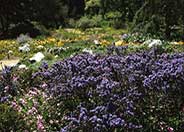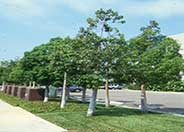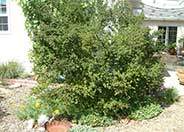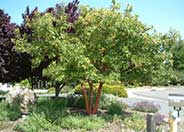

Common name:Geraldton Wax Flower
Botanical name:Chamelaucium uncinatum
This Wax Flower is a wispy, open evergreen shrub that grows to 4', bearing soft, needle-like foliage and open terminal sprays of Leptospermum-like flowers with a heavy, waxy texture. It is best known for its use as a long-lasting cut flower. This plant grows best with good drainage and little summer watering. It should be sheared after flowering in order to thicken the plant and promote flowering wood. If fertilized in fall and winter, the plant will not bloom. -Monterey Bay Nursery

Common name:Julia Phelps California Lilac
Botanical name:Ceanothus 'Julia Phelps'
Fast-growing and densely branched with small dark green leaves, this is a great bloomer showing a marvelous display of delicate, dark indigo blue flowers found in round clusters of 1". It is extremely drought tolerant, and must not be over watered. It does best in well-drained soil with little to no summer water. It attracts hummingbirds, butterflies and beneficial insects.
- Cornflower Farms

Common name:Pink Flame Tree, Queensland Lacebar
Botanical name:Brachychiton discolor
This tall tree will grow 40-75' high and will do best in full sun and well-drained soil. The rose-pink/salmon blooms it produces will open after the tree loses its leaves in late spring. The flowers and large pods are covered with a dense fuzzy coating.

Common name:California Lilac
Botanical name:Ceanothus 'Dark Star'
The 'Dark Star' grows to 4-6' tall and 6-8' wide, producing small, rounded clusters of dark blule flowers from light burgundy buds that appear in spring. Its habit is compact, with small, warty leaves growing to only 1/2" long. -Monterey Bay Nursery

Common name:Strawberry Madrone, Marina Strawber
Botanical name:Arbutus 'Marina'
The 'Marina' has gorgeous bark, with leaves that are smaller and not as glossy as Pacific Madrone. Its flowers are pink, borne in pendant clusters in the summer. The fruit is large, red and quite ornamental. The plant should be grown in sun to part shade, with little or no summer watering when established. The 'Marina' prefers good drainage. -Monterey Bay Nursery
If you mulch heavily as recommended in the compost and mulch fact sheets you should not need traditional fertilization. Sustainable landscapes fertilize themselves as soil organisms break down and recycle the dropped leaves into nutrients.
Click in the green box for more information
| Designer: Stephanie Blanc | Street View Native Front Yard |
Photographer: GardenSoft |
Practice grass-cycling by leaving short grass clippings on lawns after mowing, so that nutrients and organic matter are returned to the soil.
Mulching and adding compost to soil can minimize evaporation and help soil absorb and store water.
Drip and other smart irrigation delivers water directly to roots, allowing no excess water for weeds.